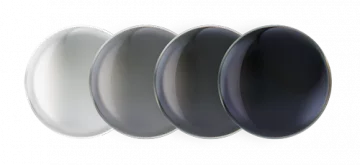Transitions™ XTRactive® Polarized™

Larger View by reducing glare, Transitions™ XTRactive® Polarized™ lenses help improve visibility by up to 33% more than non-polarised sun lenses. (3)
Vivid colours The polarisation properties of Transitions™ XTRactive® Polarized™ lenses make the world 30% more colourful. (4)
Sharper Vision Transitions™ XTRactive® Polarized™ lenses help to reduce the glare created by the sun, empowering the wearer to see through reflective surfaces such as a window, water or snow.
Optimal protection against UV and filters blue-violet light(5)
Your patients deserve the best in Photochromic lenses
- Transitions™ XTRactive® Polarized™lenses go extra dark event in hot temperatures (6)
- Achieve category 2 level of darkness in the car (7)
- Achieve up to 90% polarisation effiency (8)
- Block 100% UV light, as well as filtering blue-violet light(9)
- Transitions™ XTRactive® Polarized™ lenses activate in the car (10)
Available colours:
Grey
Unique advanced technology
Transitions™ XTRactive® Polarized™ lenses combine an exclusive multi-layer matrix with new Transitions™ XTRactive® broad-spectrum dyes for more darkness and new ultra-fast dichroic dyes for polarisation.
1 Compared to clear to dark photochromic lenses
2 EcoOptics Limited – Prof. Nicholas Roberts, Quantitative study evaluating the visual benefits of the polarisation
properties of lenses, Project 2 WP1 Dec 2020.
3 EcoOptics Limited – Prof. Nicholas Roberts, Quantitative study evaluating the visual benefits of the polarisation properties of lenses, Project 2 WP2 Feb 2021
4 EcoOptics Limited – Prof. Nicholas Roberts, Quantitative study evaluating the visual benefits of the polarisation properties of lenses, Project 2 WP2 Feb 2021
5 Compared to clear to extra dark photochromic lenses. Transitions XTRActive Polarized polycarbonate grey lenses filter 35% of blue-violet light indoors. Blue-violet light is between 400 and 455nm as stated by ISO TR 20772:2018.
6 Based on tests on polycarbonate grey lenses, up to 10% darker than the previous generation @ 23°C and up to 5% darker @ 35°C.
7 Based on tests across materials on grey lenses, achieving transmission below 45% @ 23°C behind a standard windshield. The lens achieves a polarisation efficiency of 30% behind the windshield, which is not classified as being “polarised”.
8 Based on tests across materials on grey lenses @ 23°C, using ISO 12312-1 standard.
9 Blue-violet light is between 400 and 455nm as stated by ISO TR 20772:2018.
10 Based on tests across materials on grey lenses, achieving transmission
below 45% @ 23°C behind a standard windscreen. The lens achieves a polarisation efficiency of 30% behind the windscreen, which is not classified as being “polarised”

